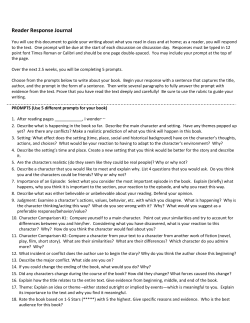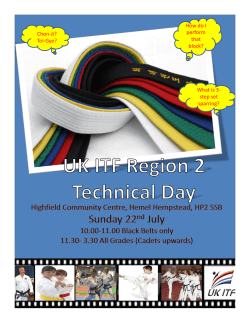
“Think Inside the Box” Crystal Lumm, M.S. CCC-SLP
“Think Inside the Box” Crystal Lumm, M.S. CCC-SLP Designing and teaching functional work tasks that tie to Alternative Performance Indicators for achievement of academic skills and facilitate development of functional communication skills for the student with limited verbal communication skills. Workshop Objectives Define Prerequisite Learning Skills for students with Autism and/or Intellectual Disabilities Learn how to develop activities that support achievement of functional communication skills, as well as, academic standards Learn the relationship of academic content standards and Alternate Performance Indicators to communication skills Alignment to Academic Standards TCAP Alt Portfolio Content Areas: Reading/Language Arts, Math, Science, Social Studies Content Standards: Algebra, Earth Science, Geometry, Geography, Economics, etc. Alternate Learning Expectations (ALE): Goals that support achievement of Content Standards Alternate Performance Indicators (API): Objectives that support achievement of ALEs TCAP is being replaced by PARCC (Partnership for Assessment of Readiness for College Careers) Learning Skills What are learning skills? • • • Prerequisite (prevocational) skills that all children need to learn in order to become independent workers in the classroom Typically, children acquire these skills “along the way” Not usually specifically taught; need to directly teach these skills to exceptional learners. Specific Skills: • • • Finished- understanding the end goal of the activity and what is needed to be finished / complete **do not take apart a completed task** Indicate finished – the ability to tell someone else that he/she is finished Need for help - understanding/recognizing the need to ask for assistance when not able to continue an activity Teaching “Finished” supports Academic Achievement? Content Area: Social Studies Content Standard: Individuals, Groups, and Interactions ALE: Explain the consequences of an individual’s decisions and actions API: Demonstrate understanding of individual responsibility OR Work independently and cooperatively to accomplish goals Specific skills continued Working independently – once an activity has started, the student’s ability to keep working through completion Rewards – understands that once an activity is complete, there is a reward– will work toward that end Wait- understands that there will be a short period of time when there will not be an activity going on and anticipates that a task will begin Specific skills continued: Refocus- the ability to be distracted for a moment but then return attention to the task Initiation – the ability to begin a task/play with out prompting or when given an ageappropriate prompt Multiple materials- able to organize performance/responses to tasks involving multiple materials Specific skills continued Trial and Error- ability to recognize that one strategy is not working and tries another Self correct – recognizes own mistakes and goes back and corrects Prompt Hierarchy Levels of prompts or cues used to elicit a Desired Response Method of documenting progress toward Independence Types of Prompts: (TCAP-Alt Portfolio Assessment) Proximity: distance from instructor is minimal Verbal: words are used to encourage completion of task Modeling: instructor demonstrates task Touch: occasional physical contact to encourage student to perform task Hand-over-Hand: instructor physically assists student’s hand in manipulation of items Full Physical: instructor completely physically assists student in manipulation of items Alternative Prompt Hierarchy: Visual Cue (V) Gesture Cue (G) Model (M) Touch or Partial Physical Assist (T) Full Physical Assist (PA) Picture Exchange Communication System Prompt Hierarchy Applies Pair picture with printed word Must be an exchange (no verbal prompt “get the picture”) Start process by using Highly Preferred Items (separate from teaching a work task) Phase I- How to Communicate Upon seeing a “highly preferred” item, the student will pick up a picture of the item, reach toward the communicative partner and release the picture into the trainer’s hand. No board is needed. Discrimination skills are not tapped. Backward Chaining Picture Exchange: Work Task: 1. Physical prompt for pick 1. Backstep to last up, reach toward correct step in the listener, release sequence. 2. Physical prompt for pick 2. Physical or gesture up, reach prompts from that step forward to complete the 3. Physical prompt for pick task up 4. Open hand cue …fade prompts …fade prompts Phase II-Distance and Persistence The student goes to his/her communication board, pulls the picture off, goes to the trainer, gets the trainers attention, and releases the picture into the trainer’s hand. Travel is involved. Phase III-Picture Discrimination The student requests desired items by going to a communication book/board, selecting the appropriate picture from an array, going to a communication partner and releasing the picture into the partner’s hand. Travel is involved. Discrimination skills are tapped. Phase IV-Sentence Structure The student requests present and non- present items using a multi-word phrase by going to the book, picking up the sentence strip “I need___” or “I want___”, placing the picture of desired item on strip, removing the strip from book, approaching the communicative partner and giving the strip to the partner. Teaching Sentence Structure supports Academic Achievement? Content Area: Social Studies Content Standard: Economics ALE: Classify needs and wants using pictures of common items (e.g. food, cleaning products, clothes, candy, and makeup) API: Distinguish between needs and wants Reinforcement What are reinforcements or rewards? Incentives to continue to work or learn, motivators to do well , ****MUST be desired/chosen by child**** will not work if others choose , and might change often Types of reinforcements Tangibles Praise Natural consequences Use of self Breaks Visual Schedule Keep it consistent in form Need to teach student how to use it The teacher is in charge! Teaching use of a Visual Schedule supports Academic Achievement? Content Area: Science Content Standard: Earth Science ALE: Recognize that there are predictable patterns in the universe API: Sequence daily events in relation to the student’s environment (e.g. schedule) “I’m finished” Functional? Examples: Insert blocks into a can Clothespins into a holder “I’m finished” Functional Examples: Coins into a bank Fold washcloths Flowers into vases Sort silverware Sort hair supplies Sort school tools Sort fruit Sort flowers by color or form (type of flower) Sort clothing by season Sort items to be recycled (glass, plastic, paper) Sorting Activities support Academic Achievement? Content Area: Math Content Standard: Algebra ALE: The student will sort and classify objects by size, number , and other properties API: Sort objects by two attributes (e.g. color, size, or shape) Simple Tasks to Sabotage: Insert cards into envelopes Eraser caps onto pencils Toothbrushes into travel cases Eyeglasses or sunglasses into cases Band aids into first aid kits Match lids to containers Match socks, mittens, gloves Match shoes by size, shape, color Match bathing suit tops to bottoms Matching Activities support Academic Achievement? Content Area: Math Content Standard: Algebra ALE: The student will represent and analyze patterns and functions API: Identify objects as same or different Expand the functional task Count the band aids, then put ALL into kit Count the pencils, then put ALL into container Sort the items, then put ONE OF EACH into container (school tools, grooming supplies, silverware, fruit or flowers to make centerpieces, etc.) Let’s fix it! Sort First Sort flashlights….Working vs. Not working Sort containers…Full vs. Empty Next, fix it “I need a battery.” “I need more.” “It doesn’t fit.”
© Copyright 2025





















